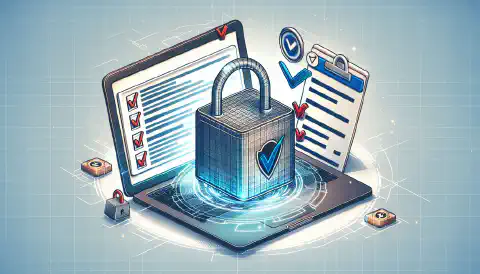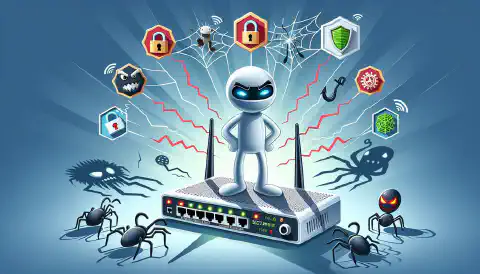Navigating the Blockchain Landscape: Unraveling Fundamentals, Applications, and Future Trends

Table of Contents
Exploring the World of Crypto: Understanding Blockchain Technology
Blockchain technology has revolutionized the way we perceive and conduct transactions in the digital world. Its decentralized and secure nature has paved the way for innovative applications across various industries. Understanding the fundamentals and potential challenges of blockchain technology is crucial for navigating its complex landscape.
Key Takeaways
- Blockchain technology is based on cryptography, ensuring secure and private transactions.
- Decentralization eliminates the need for a central authority, promoting transparency and trust.
- Consensus mechanisms enable agreement among network participants, ensuring the validity of transactions.
- Blockchain technology has transformative applications in financial services, supply chain management, and the healthcare industry.
- Challenges such as scalability, regulatory compliance, and interoperability need to be addressed for widespread adoption of blockchain technology.
The Fundamentals of Blockchain Technology
Understanding Cryptography
Cryptography is a foundational element of blockchain technology, providing the means to secure and authenticate transactions. It involves the use of mathematical algorithms to encrypt and decrypt data, ensuring the confidentiality and integrity of information. Through the utilization of public and private keys, cryptography enables secure digital communication and transaction verification. This process plays a crucial role in safeguarding the immutability and trustworthiness of blockchain data.
- Cryptography ensures secure communication
- It enables transaction verification
- Protects data confidentiality and integrity
Tip: The use of cryptography is essential for maintaining the security and privacy of blockchain transactions.
Decentralization
As a cybersecurity expert, understanding cryptography is paramount in comprehending the security aspects of blockchain technology. Cryptography plays a pivotal role in securing transactions, ensuring data integrity, and providing authentication mechanisms within a decentralized network. The use of public key infrastructure (PKI) and cryptographic algorithms such as SHA-256 and Elliptic Curve Cryptography (ECC) are fundamental to the security of blockchain transactions. These cryptographic techniques form the foundation of trust and security in blockchain systems.
Consensus Mechanisms
Consensus mechanisms are a critical component of blockchain technology, ensuring the integrity and security of the distributed ledger. These mechanisms enable nodes in the network to agree on the validity of transactions, thereby preventing double spending and maintaining the immutability of the ledger. The selection of a consensus mechanism is a pivotal decision in blockchain design, as it directly impacts the system’s performance, security, and scalability. Different consensus mechanisms, such as Proof of Work (PoW), Proof of Stake (PoS), and Delegated Proof of Stake (DPoS), offer varying trade-offs in terms of efficiency, security, and decentralization. Understanding the nuances of each mechanism is crucial for architects and developers to make informed decisions when designing blockchain solutions. Implementing the most suitable consensus mechanism is essential for the success of blockchain applications in various industries.
Applications of Blockchain Technology

Financial Services
As a cybersecurity expert, the application of blockchain technology in Financial Services is of paramount importance. Understanding the intricacies of cryptographic protocols and decentralization is crucial in safeguarding financial data. The consensus mechanisms employed in blockchain networks ensure a high level of security and trust in financial transactions. Leveraging blockchain for financial services requires a deep understanding of blockchain economics and its impact on traditional financial systems.
- Blockchain technology ensures secure and transparent financial transactions.
- Cryptographic protocols play a vital role in protecting financial data.
- Decentralization eliminates single points of failure in financial systems.
- Consensus mechanisms ensure trust and security in financial transactions.
It is imperative for financial institutions to adapt to the evolving landscape of blockchain economics and its impact on traditional financial models.
Supply Chain Management
As a cybersecurity expert, the application of blockchain technology in supply chain management is of paramount importance. The decentralized and immutable nature of blockchain provides a secure and transparent framework for tracking and verifying the flow of goods and information across the supply chain.
This technology ensures the integrity and authenticity of data, reducing the risk of fraud, counterfeiting, and unauthorized access. By leveraging blockchain, supply chain stakeholders can establish a trusted and auditable record of transactions, enhancing accountability and traceability throughout the entire supply chain network.
Furthermore, the implementation of blockchain technology in supply chain management can lead to significant improvements in efficiency, cost reduction, and risk mitigation. The use of smart contracts and automated processes can streamline operations, minimize errors, and optimize inventory management, ultimately fostering a more resilient and agile supply chain ecosystem.
- Enhanced data security and integrity
- Improved transparency and traceability
- Efficient supply chain operations
It is essential for organizations to carefully evaluate the integration of blockchain technology in supply chain management, considering factors such as interoperability with existing systems, regulatory compliance, and the need for standardized protocols and data formats.
Healthcare Industry
The healthcare industry is an area where blockchain technology holds significant promise. Its potential to secure sensitive patient data and enable transparent public transactions is of great interest to cybersecurity experts. The decentralized nature of blockchain ensures that patient records are tamper-proof and secure, reducing the risk of unauthorized access. Furthermore, the use of smart contracts in healthcare can streamline processes and automate compliance with regulatory standards. This technology has the potential to revolutionize the way healthcare data is managed and shared, leading to improved patient care and data integrity.
- Enhanced security for patient data
- Transparency in transactions
- Automation of compliance processes
Tip: Implementing blockchain in healthcare requires careful consideration of privacy regulations and data governance policies.
Challenges and Limitations of Blockchain Technology

Scalability
Scalability is a critical concern in the realm of blockchain technology. As the network grows, the ability to handle an increasing number of transactions becomes paramount. Uncertainty surrounding the scalability of blockchain solutions has led to ongoing research and development efforts. This has resulted in the exploration of various consensus mechanisms and network architectures to address this challenge. Additionally, the potential impact of scalability on decentralization and security cannot be overlooked. The table below illustrates the comparative transaction throughput of popular blockchain platforms.
Regulatory Compliance
Regulatory compliance is a critical aspect of blockchain technology perspectives. It involves ensuring that blockchain systems adhere to the legal and regulatory requirements set forth by governing bodies. This includes data protection laws, financial regulations, and industry-specific compliance standards. Maintaining regulatory compliance is essential for the widespread adoption of blockchain technology, as it instills trust and confidence in the integrity of the system. Failure to meet regulatory standards can result in legal repercussions and damage the reputation of blockchain initiatives.
- Implementing robust identity verification processes
- Adhering to data privacy regulations
- Ensuring transparency and auditability of transactions
It is imperative for organizations to prioritize regulatory compliance in their blockchain implementations to mitigate legal risks and foster a secure and trustworthy ecosystem for blockchain technology.
Interoperability
Interoperability is a critical challenge in the realm of blockchain technology. It refers to the ability of different blockchain networks to communicate and interact with each other seamlessly. Achieving interoperability is essential for the widespread adoption and integration of blockchain solutions across various industries. The lack of standardized protocols and communication methods hinders the seamless exchange of data and transactions between disparate blockchain platforms. This poses a significant obstacle to the realization of a truly interconnected and efficient blockchain ecosystem. To address this challenge, industry stakeholders are actively exploring innovative solutions and protocols to enable seamless interoperability among diverse blockchain networks. One approach involves the development of cross-chain communication protocols and interoperability standards to facilitate secure and efficient data exchange. Additionally, the establishment of industry-wide consortia and collaborative initiatives plays a pivotal role in driving the blockchain revolution forward by fostering interoperability and standardization. As the blockchain revolution continues to unfold, addressing the interoperability challenge will be crucial for unlocking the full potential of blockchain technology across global sectors.
Future Trends in Blockchain Technology

Tokenization of Assets
As a cybersecurity expert, the trend of tokenization of assets presents significant implications for digital security. Tokenization involves the conversion of real-world assets into digital tokens, providing a mechanism for representing ownership and facilitating transparent transactions. This process enhances the security and integrity of asset ownership by leveraging cryptography and decentralized consensus mechanisms. Furthermore, the integration of tokenization with blockchain technology introduces new challenges in ensuring secure and transparent transactions. The use of smart contracts and digital signatures plays a crucial role in enabling secure and tamper-resistant transactions. Additionally, the implementation of governance models for tokenized assets requires careful consideration of security protocols and regulatory compliance. It is imperative for cybersecurity professionals to stay abreast of these developments and actively contribute to the design and implementation of secure tokenization frameworks.
Integration with IoT
As a cybersecurity expert, the integration of Blockchain Technology with the Internet of Things (IoT) presents unique security challenges and opportunities. The convergence of these two technologies introduces complex considerations for securing interconnected devices and data.
The decentralized nature of Blockchain provides a potential solution for securing IoT devices and data, offering enhanced protection against unauthorized access and tampering. However, the distributed nature of Blockchain also introduces new attack vectors and vulnerabilities that must be carefully addressed.
To effectively secure the integration of Blockchain with IoT, it is crucial to implement robust cryptographic protocols and authentication mechanisms. Additionally, the development of standardized security frameworks and protocols tailored for Blockchain-IoT integration is imperative to mitigate potential risks and ensure the integrity of connected devices and data.
Furthermore, the use of secure hardware modules and secure enclaves can bolster the security of Blockchain-IoT systems, providing a hardware-based root of trust for critical operations and data protection.
It is essential for cybersecurity professionals to stay abreast of the evolving landscape of Blockchain-IoT security, continuously evaluating and adapting security measures to address emerging threats and vulnerabilities.
Key Considerations for Securing Blockchain-IoT Integration:
| Consideration | Description |
|---|---|
| Cryptographic Protocols | Implementation of robust encryption and cryptographic algorithms to secure data transmission and storage. |
| Authentication Mechanisms | Deployment of strong authentication methods to verify the identity of connected devices and users. |
| Standardized Security Frameworks | Development and adoption of standardized security frameworks tailored for Blockchain-IoT integration. |
| Secure Hardware Modules | Utilization of secure hardware modules and enclaves to establish a hardware-based root of trust for critical operations and data protection. |
It is imperative to prioritize security measures that address the unique challenges posed by the integration of Blockchain and IoT, ensuring the confidentiality, integrity, and availability of interconnected systems and data.
Governance Models
Governance models play a crucial role in the future of blockchain technology. As a cybersecurity expert, it is imperative to understand the implications of governance models on the security and integrity of blockchain networks. Transparency and accountability are key principles that governance models aim to uphold, ensuring the tamper-proof ledger characteristic of blockchain technology. These models establish the framework for decision-making, protocol updates, and network security measures. Additionally, governance models contribute to the resilience and trustworthiness of blockchain networks, which are essential for widespread adoption and long-term viability. It is important for cybersecurity professionals to stay informed about emerging governance models and their impact on the security landscape of blockchain technology.
Conclusion
In conclusion, the exploration of blockchain technology has provided valuable insights into its fundamentals and diverse applications. However, it is important to acknowledge the challenges and limitations that accompany its implementation. Looking ahead, the future trends in blockchain technology present opportunities for innovation and advancement. As the technology continues to evolve, it is essential for stakeholders to address the existing challenges and work towards establishing robust governance models. This article serves as a foundational resource for understanding the complexities and potential of blockchain technology in various industries.
Frequently Asked Questions
What is blockchain technology?
Blockchain technology is a decentralized and distributed ledger system that records transactions across a network of computers. It ensures transparency, security, and immutability of data.
How does blockchain use cryptography?
Blockchain uses cryptographic techniques to secure and authenticate transactions. This includes hashing, digital signatures, and encryption to ensure the integrity and privacy of data.
What are the challenges of blockchain scalability?
Blockchain scalability refers to the ability of a blockchain network to handle a large number of transactions. Challenges include network congestion, transaction speed, and resource requirements.
How does blockchain ensure decentralization?
Blockchain achieves decentralization by distributing data and processing across a network of nodes, eliminating the need for a central authority or intermediary.
What are the regulatory challenges of blockchain technology?
Regulatory challenges include compliance with existing financial and data protection laws, as well as the need for new regulations to address the unique aspects of blockchain technology.
What are the potential applications of blockchain in healthcare?
Blockchain can be used in healthcare for secure patient data management, interoperable health records, supply chain transparency, and authentication of medical products and services.






